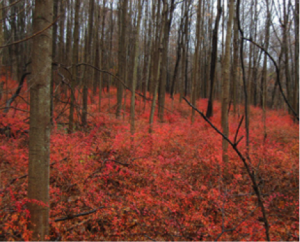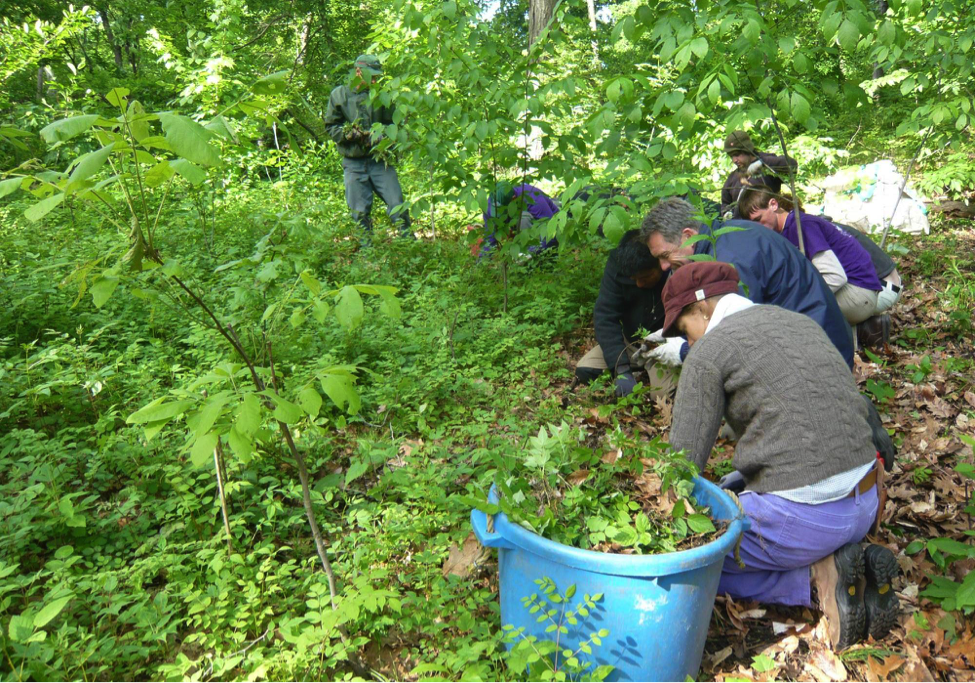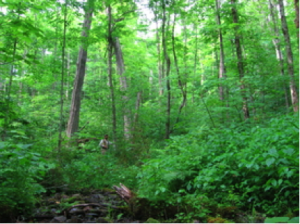Not For Sale: Invasive Plants Regulated in New York State
Posted in Horticulture on March 9 2015, by Jessica Schuler
Jessica Arcate Schuler is NYBG‘s Director of the Thain Family Forest.

On March 10, 2015, the sale of 75 plant species will be prohibited or regulated in New York State because of their invasiveness and “to help control invasive species, a form of biological pollution, by reducing the introduction of new and spread of existing populations there by having a positive impact on the environment (NYS DEC, 6 NYCRR Part 575 Prohibited and Regulated Invasive Species, 2014).” This is a big step in the ongoing battle with invasive species or non-native species that cause harm—harm to human health, economic harm, or ecological harm (Executive Order 13112, 1999).
New York first proposed these regulations through the Invasive Species Council in 2010, “A Regulatory System for Non-native Species,” that defined a process to prohibit, regulate, and evaluate unlisted non-native species. As you read through the 75 listed plant species in New York’s regulations, they are all species already known to cause ecological harm and are broadly established in the region. Blacklisting a species in law is one way to prevent further spread. However, “it is difficult to get a species on a blacklist unless it has already caused damage, and by then it is usually too late because the great majority of established introductions are irrevocable (Simberloff, 2001).”
In this era of the Anthropocene, species are circumventing the globe at a greater rate than ever before. The reality is that there are currently many non-native species already established and it is extremely difficult to predict which ones will become invasive. So, what does this all mean to gardeners, landscape architects, landscape designers, landscape professionals, and students alike?

The answer has two folds: (1) There are common garden plants that have been used for decades that can no longer be used, including Japanese barberry (Berberis thunbergii), border privet (Ligustrum obtusifolia), bamboos (Phyllostachys aurea and Phyllostachys aureosulcata), and should no longer be used, such as Norway maple (Acer platanoides), Japanese virgin’s bower (Clematis terniflora), burning bush (Euonymus alatus), winter creeper (Euonymus fortunei), Chinese silver grass (Miscanthus sinensis), and black locust (Robinia pseudoacacia); (2) This is simply a wakeup call to be conscientious horticulturists that are aware of the complex conservation issues at stake, the role we play while working in the creative spaces we make, and being fully aware that our gardens can have a tremendous and potentially detrimental impact on the surrounding landscape.

We have to be exceptional plantsmen and plantswomen as well as ecologists and conservation biologists. Scientists are busy working to better understand the mechanisms that cause invasiveness but, in reality, every species is different and every landscape is different. It is an extremely difficult and complex problem to predict future invasive species. By being aware and taking a step back, we need to learn from our past and help prevent future invasions. This starts from being observant and educated horticulturists. If you see a species becoming “aggressive” or naturalizing, say something. If you can use a native alternative in a design, do. If you have a customer that insists on planting an invasive or potentially invasive species, educate them. Most importantly, keep up to speed on the most recent research and conservation issues effecting the region. We can all work together to prevent future invasions and to conserve the wonderfully biodiverse ecosystems of New York State and the Tristate region.
Attend the iMapInvasives Training at the Garden on March 18, 2015 12 p.m.–3 p.m. Head through for more info and registration.
Simberloff, D. 2001. Biological Invasions—How are they affecting us, and what can we do about them? Western North American Naturalist 61(3): 308-315.

